Adhesive Joint Degradation Due to Hardener-to-Epoxy Ratio Inaccuracy under Varying Curing and Thermal Operating Conditions
Abstract
:1. Introduction
- (1)
- adherend
- failure of one or both adherends—substrate failure,
- failure of an adherend—cohesive substrate failure,
- failure through lamination—delamination failure,
- (2)
- adhesive
- Cohesion failure
- Cohesion failure
- Special cohesion failure
- Failure with stress whitening of adhesive
- Adhesion failure
- Adhesion and cohesion failure with peel
- (3)
- Corrosion at the interface—debonding due to bondline corrosion.
2. Materials and Methods
2.1. Materials and Sample Preparation
2.2. Mechanical Testing
2.3. Statistical Analysis
2.4. Mathematical Modelling
3. Results
4. Discussion
5. Conclusions
Author Contributions
Funding
Institutional Review Board Statement
Informed Consent Statement
Data Availability Statement
Conflicts of Interest
References
- Fay, P.A. A History of Adhesive Bonding. In Adhesive Bonding; Elsevier: Amsterdam, The Netherlands, 2021; pp. 3–40. ISBN 978-0-12-819954-1. [Google Scholar]
- Chandrasekaran, N.K.; Arunachalam, V. State-of-the-art Review on Honeycomb Sandwich Composite Structures with an Emphasis on Filler Materials. Polym. Compos. 2021, 42, 5011–5020. [Google Scholar] [CrossRef]
- Comyn, J. Adhesion Science, 2nd ed.; Royal Society of Chemistry: London, UK, 2021; ISBN 978-1-78801-888-3. [Google Scholar]
- Rudawska, A.; Worzakowska, M.; Bociąga, E.; Olewnik-Kruszkowska, E. Investigation of Selected Properties of Adhesive Compositions Based on Epoxy Resins. Int. J. Adhes. Adhes. 2019, 92, 23–36. [Google Scholar] [CrossRef]
- Rudawska, A.; Szabelski, J.; Miturska, I.; Doluk, E. Strength of Solder and Adhesive Joints of Copper Sheets. In Proceedings of the 9th International Conference on Fracture, Fatigue and Wear, Ghent, Belgium, 2–3 August 2021; Abdel Wahab, M., Ed.; Lecture Notes in Mechanical Engineering. Springer: Singapore, 2022; pp. 85–95, ISBN 9789811688096. [Google Scholar]
- Doluk, E.; Rudawska, A.; Stančeková, D.; Mrázik, J. Influence of Surface Treatment on the Strength of Adhesive Joints. Manuf. Technol. 2021, 21, 585–591. [Google Scholar] [CrossRef]
- Ozun, E.; Ceylan, R.; Özgür Bora, M.; Çoban, O.; Kutluk, T. Combined Effect of Surface Pretreatment and Nanomaterial Reinforcement on the Adhesion Strength of Aluminium Joints. Int. J. Adhes. Adhes. 2022, 114, 103274. [Google Scholar] [CrossRef]
- Miturska, I.; Rudawska, A.; Müller, M.; Valášek, P. The Influence of Modification with Natural Fillers on the Mechanical Properties of Epoxy Adhesive Compositions after Storage Time. Materials 2020, 13, 291. [Google Scholar] [CrossRef] [Green Version]
- Park, S.-J. Thermal Stability and Fracture Toughness of Epoxy Resins Modified with Epoxidized Castor Oil and Al2O3 Nanoparticles. Bull. Korean Chem. Soc. 2012, 33, 2513–2516. [Google Scholar] [CrossRef] [Green Version]
- Kumar, R.; Mohanty, S.; Nayak, S.K. Thermal Conductive Epoxy Adhesive Composites Filled with Carbon-Based Particulate Fillers: A Comparative Study. J. Adhes. Sci. Technol. 2020, 34, 807–827. [Google Scholar] [CrossRef]
- Kim, H.-J.; Lim, D.-H.; Hwang, H.-D.; Lee, B.-H. Composition of Adhesives. In Handbook of Adhesion Technology; da Silva, L.F.M., Öchsner, A., Adams, R.D., Eds.; Springer International Publishing: Cham, Switzerland, 2018; pp. 319–343. ISBN 978-3-319-55410-5. [Google Scholar]
- Frigione, M.; Lettieri, M. Recent Advances and Trends of Nanofilled/Nanostructured Epoxies. Materials 2020, 13, 3415. [Google Scholar] [CrossRef]
- Rudawska, A.; Miturska, I. Impact Study of Single Stage and Multi Stage Abrasive Machining on Static Strength of Lap Adhesive Joints of Mild Steel. MATEC Web Conf. 2018, 244, 02006. [Google Scholar] [CrossRef]
- Miturska, I.; Rudawska, A.; Müller, M.; Hromasová, M. The Influence of Mixing Methods of Epoxy Composition Ingredients on Selected Mechanical Properties of Modified Epoxy Construction Materials. Materials 2021, 14, 411. [Google Scholar] [CrossRef]
- Godzimirski, J.; Komorek, A. The Influence of Selected Test Conditions on the Impact Strength of Adhesively Bonded Connections. Materials 2020, 13, 1320. [Google Scholar] [CrossRef] [PubMed] [Green Version]
- Doluk, E.; Rudawska, A.; Brunella, V. The Influence of Technological Factors on the Strength of Adhesive Joints of Steel Sheets. Adv. Sci. Technol. Res. J. 2020, 14, 107–115. [Google Scholar] [CrossRef]
- Savvilotidou, M.; Vassilopoulos, A.P.; Frigione, M.; Keller, T. Development of Physical and Mechanical Properties of a Cold-Curing Structural Adhesive in a Wet Bridge Environment. Constr. Build. Mater. 2017, 144, 115–124. [Google Scholar] [CrossRef]
- Petrie, E.M. Handbook of Adhesives and Sealants, 3rd ed.; McGraw-Hill: New York, NY, USA, 2021; ISBN 978-1-260-44044-7. [Google Scholar]
- Packham, D.E. (Ed.) Handbook of Adhesion, 2nd ed.; John Wiley: Hoboken, NJ, USA, 2005; ISBN 978-0-471-80874-9. [Google Scholar]
- Standard PN-EN ISO 10365:2022; Adhesives—Designation of Main Failure Patterns. ISO: Warszawa, Poland, 2022.
- Gallas, S.; Devriendt, H.; Croes, J.; Naets, F.; Desmet, W. Experimental Model Update for Single Lap Joints. In Nonlinear Structures & Systems, Volume 1; Brake, M.R.W., Renson, L., Kuether, R.J., Tiso, P., Eds.; Conference Proceedings of the Society for Experimental Mechanics Series; Springer International Publishing: Cham, Switzerland, 2023; pp. 177–180. ISBN 978-3-031-04085-6. [Google Scholar]
- Rozylo, P. Stability and Failure of Compressed Thin-walled Composite Columns Using Experimental Tests and Advanced Numerical Damage Models. Int. J. Numer. Methods Eng. 2021, 122, 5076–5099. [Google Scholar] [CrossRef]
- Jonak, J.; Karpiński, R.; Wójcik, A.; Siegmund, M.; Kalita, M. Determining the Effect of Rock Strength Parameters on the Breakout Area Utilizing the New Design of the Undercut/Breakout Anchor. Materials 2022, 15, 851. [Google Scholar] [CrossRef]
- Falkowicz, K.; Debski, H.; Wysmulski, P. Effect of Extension-Twisting and Extension-Bending Coupling on a Compressed Plate with a Cut-Out. Compos. Struct. 2020, 238, 111941. [Google Scholar] [CrossRef]
- Rozylo, P. Experimental-Numerical Study into the Stability and Failure of Compressed Thin-Walled Composite Profiles Using Progressive Failure Analysis and Cohesive Zone Model. Compos. Struct. 2021, 257, 113303. [Google Scholar] [CrossRef]
- Liu, P.F.; Liu, J.W.; Wang, C.Z. Finite Element Analysis of Damage Mechanisms of Composite Wind Turbine Blade by Considering Fluid/Solid Interaction. Part II: T-Shape Adhesive Structure. Compos. Struct. 2022, 301, 116211. [Google Scholar] [CrossRef]
- Wysmulski, P.; Debski, H.; Falkowicz, K.; Rozylo, P. The Influence of Load Eccentricity on the Behavior of Thin-Walled Compressed Composite Structures. Compos. Struct. 2019, 213, 98–107. [Google Scholar] [CrossRef]
- Falkowicz, K.; Debski, H. The Post-Critical Behaviour of Compressed Plate with Non-Standard Play Orientation. Compos. Struct. 2020, 252, 112701. [Google Scholar] [CrossRef]
- Romero, A.; Galvín, P.; Domínguez, J. 3D Non-Linear Time Domain FEM–BEM Approach to Soil–Structure Interaction Problems. Eng. Anal. Bound. Elem. 2013, 37, 501–512. [Google Scholar] [CrossRef]
- Romero, A.; Galvín, P.; Tadeu, A. An Accurate Treatment of Non-Homogeneous Boundary Conditions for Development of the BEM. Eng. Anal. Bound. Elem. 2020, 116, 93–101. [Google Scholar] [CrossRef]
- Machrowska, A.; Karpiński, R.; Jonak, J.; Szabelski, J.; Krakowski, P. Numerical Prediction of the Component-Ratio-Dependent Compressive Strength of Bone Cement. Appl. Comput. Sci. 2020, 16, 87–101. [Google Scholar] [CrossRef]
- Machrowska, A.; Szabelski, J.; Karpiński, R.; Krakowski, P.; Jonak, J.; Jonak, K. Use of Deep Learning Networks and Statistical Modeling to Predict Changes in Mechanical Parameters of Contaminated Bone Cements. Materials 2020, 13, 5419. [Google Scholar] [CrossRef] [PubMed]
- Rogala, M.; Gajewski, J.; Górecki, M. Study on the Effect of Geometrical Parameters of a Hexagonal Trigger on Energy Absorber Performance Using ANN. Materials 2021, 14, 5981. [Google Scholar] [CrossRef]
- Szabelski, J.; Karpiński, R.; Machrowska, A. Application of an Artificial Neural Network in the Modelling of Heat Curing Effects on the Strength of Adhesive Joints at Elevated Temperature with Imprecise Adhesive Mix Ratios. Materials 2022, 15, 721. [Google Scholar] [CrossRef]
- Bauer, L.; Stütz, L.; Kley, M. Black Box Efficiency Modelling of an Electric Drive Unit Utilizing Methods of Machine Learning. ACS 2021, 17, 5–19. [Google Scholar] [CrossRef]
- Dsouza, K.J.; Ansari, Z.A. Histopathology Image Classification Using Hybrid Parallel Structured DEEP-CNN Models. Appl. Comput. Sci. 2022, 18, 20–36. [Google Scholar]
- Jonak, J.; Karpiński, R.; Siegmund, M.; Machrowska, A.; Prostański, D. Experimental Verification of Standard Recommendations for Estimating the Load-Carrying Capacity of Undercut Anchors in Rock Material. Adv. Sci. Technol. Res. J. 2021, 15, 1–15. [Google Scholar] [CrossRef]
- Świć, A.; Gola, A. Theoretical and Experimental Identification of Frequency Characteristics and Control Signals of a Dynamic System in the Process of Turning. Materials 2021, 14, 2260. [Google Scholar] [CrossRef]
- Berzins, R.; Merijs Meri, R.; Zicans, J. Different Epoxide Compound Influence on Two Component Silyl-Terminated Polymer/Epoxide Systems Mechanical, Rheological and Adhesion Properties. IOP Conf. Ser. Mater. Sci. Eng. 2019, 500, 012032. [Google Scholar] [CrossRef]
- Szabelski, J.; Karpiński, R.; Krakowski, P.; Jojczuk, M.; Jonak, J.; Nogalski, A. Analysis of the Effect of Component Ratio Imbalances on Selected Mechanical Properties of Seasoned, Medium Viscosity Bone Cements. Materials 2022, 15, 5577. [Google Scholar] [CrossRef] [PubMed]
- Karpinski, R.; Szabelski, J.; Maksymiuk, J. Analysis of the Properties of Bone Cement with Respect to Its Manufacturing and Typical Service Lifetime Conditions. MATEC Web Conf. 2018, 244, 01004. [Google Scholar] [CrossRef]
- Karpiński, R.; Szabelski, J.; Maksymiuk, J. Seasoning Polymethyl Methacrylate (PMMA) Bone Cements with Incorrect Mix Ratio. Materials 2019, 12, 3073. [Google Scholar] [CrossRef] [PubMed] [Green Version]
- Szabelski, J. Effect of Incorrect Mix Ratio on Strength of Two Component Adhesive Butt-Joints Tested at Elevated Temperature. MATEC Web Conf. 2018, 244, 01019. [Google Scholar] [CrossRef] [Green Version]
- Rabiej, M. Analizy Statystyczne z Programami Statistica i Excel; Wydawnictwo Helion: Gliwice, Poland, 2018; ISBN 978-83-283-3922-4. [Google Scholar]
- Ross, S.M. Introduction to Probability and Statistics for Engineers and Scientist, 6th ed.; Elsevier/Academic Press: London, UK, 2021; ISBN 978-0-12-824346-6. [Google Scholar]
- Navidi, W.C. Statistics for Engineers and Scientists, 3rd ed.; McGraw-Hill: New York, NY, USA, 2011; ISBN 978-0-07-337633-2. [Google Scholar]
- Devore, J.L.; Farnum, N.R.; Doi, J. Applied Statistics for Engineers and Scientists, 3rd ed.; Cengage Learning: Stamford, CT, USA, 2014; ISBN 978-1-133-11136-8. [Google Scholar]
- Heilio, M.L.; Lähivaara, T.; Laitinen, E.; Mantere, T.; Merikoski, J.; Pohjolainen, S.; Raivio, K.; Silvennoinen, R.; Suutala, A.; Tarvainen, T.; et al. Mathematical Modelling; Springer: Berlin/Heidelberg, Germany, 2018; ISBN 978-3-319-80226-8. [Google Scholar]
- Rudawska, A.; Miturska-Barańska, I.; Doluk, E.; Olewnik-Kruszkowska, E. Assessment of Surface Treatment Degree of Steel Sheets in the Bonding Process. Materials 2022, 15, 5158. [Google Scholar] [CrossRef]
- Miturska-Barańska, I.; Rudawska, A. Effect of Surface Abrasive Treatment on the Strength of Galvanised Steel Sheet Adhesive Joints. Adv. Sci. Technol. Res. J. 2022, 16, 75–84. [Google Scholar] [CrossRef]
- Miturska-Barańska, I.; Rudawska, A. Influence of Adhesive Compound Viscosity on the Strength Properties of 1.0503 Steel Sheets Adhesive Joints. Adv. Sci. Technol. Res. J. 2022, 16, 196–205. [Google Scholar] [CrossRef]
- Rudawska, A.; Zaleski, K.; Miturska, I.; Skoczylas, A. Effect of the Application of Different Surface Treatment Methods on the Strength of Titanium Alloy Sheet Adhesive Lap Joints. Materials 2019, 12, 4173. [Google Scholar] [CrossRef] [Green Version]
- Kim, D.; Nutt, S.R. Processability of DDS Isomers-Cured Epoxy Resin: Effects of Amine/Epoxy Ratio, Humidity, and out-Time: Processability of DDs Isomers-Cured Epoxy Resin: Effects of Amine/Epoxy Ratio, Humidity, and Out-Time. Polym. Eng. Sci. 2018, 58, 1530–1538. [Google Scholar] [CrossRef]
- Ladaniuc, M.A.; Hubca, G.; Gabor, R.; Andi-Nicolae, C.; Sandu, T. Study on the Reactants Molar Ratio Influence on the Properties of Standard Epoxy Resin/Glycols-Modified Epoxy Resin Compounds. Mater. Plast. 2015, 52, 433–436. [Google Scholar]
- Odagiri, N.; Shirasu, K.; Kawagoe, Y.; Kikugawa, G.; Oya, Y.; Kishimoto, N.; Ohuchi, F.S.; Okabe, T. Amine/Epoxy Stoichiometric Ratio Dependence of Crosslinked Structure and Ductility in AMINE-CURED Epoxy Thermosetting Resins. J. Appl. Polym. Sci. 2021, 138, 50542. [Google Scholar] [CrossRef]
- Wang, H.; Li, S.; Yuan, Y.; Liu, X.; Sun, T.; Wu, Z. Study of the Epoxy/Amine Equivalent Ratio on Thermal Properties, Cryogenic Mechanical Properties, and Liquid Oxygen Compatibility of the Bisphenol A Epoxy Resin Containing Phosphorus. High Perform. Polym. 2020, 32, 429–443. [Google Scholar] [CrossRef]
- Fernandez-Nograro, F.; Valea, A.; Llano-Ponte, R.; Mondragon, I. Dynamic and Mechanical Properties of DGEBA/Poly(Propylene Oxide) Amine Based Epoxy Resins as a Function of Stoichiometry. Eur. Polym. J. 1996, 32, 257–266. [Google Scholar] [CrossRef]
- Garifullin, N.O.; Komarov, B.A.; Kapasharov, A.T.; Malkov, G.V. Dependence of the Physical-Mechanical Properties of Cured Epoxy-Amine Resin on the Ratio of Its Components. KEM 2019, 816, 146–150. [Google Scholar] [CrossRef]
- Minty, R.F.; Thomason, J.L.; Yang, L. The Role of the Epoxy Resin: Curing Agent Ratio on Composite Interfacial Strength and Thermal Performance. In Proceedings of the European Conference on Composite Materials-ECCM 17, Munich, Germany, 26–30 June 2016. [Google Scholar]
- Minty, R.; Thomason, J.; Petersen, H. The Role of the Epoxy Resin: Curing Agent Ratio in Composite Interfacial Strength by Single Fibre Microbond Test. In Proceedings of the 20th International Conference on Composite Materials, Copenhagen, Denmark, 19–24 July 2015. [Google Scholar]
- Islam, M.S.; Pickering, K.L. Influence of Alkali Treatment on the Interfacial Bond Strength of Industrial Hemp Fibre Reinforced Epoxy Composites: Effect of Variation from the Ideal Stoicheometric Ratio of Epoxy Resin to Curing Agent. In Advanced Materials Research; Trans Tech Publications Ltd.: Stafa, Switzerland, 2007; Volume 29–30, pp. 319–322. ISBN 978-0-87849-466-8. [Google Scholar]
- Pang, K.P.; Gillham, J.K. Anomalous Behavior of Cured Epoxy Resins: Density at Room Temperature versus Time and Temperature of Cure. J. Appl. Polym. Sci. 1989, 37, 1969–1991. [Google Scholar] [CrossRef]
- Michel, M.; Ferrier, E. Effect of Curing Temperature Conditions on Glass Transition Temperature Values of Epoxy Polymer Used for Wet Lay-up Applications. Constr. Build. Mater. 2020, 231, 117206. [Google Scholar] [CrossRef]
- Chandrathilaka, E.R.K.; Gamage, J.C.P.H.; Fawzia, S. Effects of Elevated Temperature Curing on Glass Transition Temperature of Steel/CFRP Joint and Pure Epoxy Adhesive. EJSE 2018, 18, 1–6. [Google Scholar] [CrossRef]
- Musa, A.; Alamry, K.A.; Hussein, M.A. The Effect of Curing Temperatures on the Thermal Behaviour of New Polybenzoxazine-Modified Epoxy Resin. Polym. Bull. 2020, 77, 5439–5449. [Google Scholar] [CrossRef]
- Jin, N.J.; Yeon, J.; Seung, I.; Yeon, K.-S. Effects of Curing Temperature and Hardener Type on the Mechanical Properties of Bisphenol F-Type Epoxy Resin Concrete. Constr. Build. Mater. 2017, 156, 933–943. [Google Scholar] [CrossRef]
- Rudawska, A. The Influence of Curing Conditions on the Strength of Adhesive Joints. J. Adhes. 2020, 96, 402–422. [Google Scholar] [CrossRef]
- Rudawska, A.; Czarnota, M. Selected Aspects of Epoxy Adhesive Compositions Curing Process. J. Adhes. Sci. Technol. 2013, 27, 1933–1950. [Google Scholar] [CrossRef]
- Dai, P.; Wang, Y.; Huang, Z. Effect of Thermal Crosslink Conditions on Dynamic Mechanical Behaviors of Flexible Epoxy. J. Wuhan Univ. Technol.-Mat. Sci. Edit. 2008, 23, 825–829. [Google Scholar] [CrossRef]
- Goda, Y.; Sawa, T.; Himuro, K.; Yamamoto, K. Impact Strength Degradation of Adhesive Joints Under Heat and Moisture Environmental Conditions. In Volume 9: Mechanics of Solids, Structures and Fluids; ASMEDC: Vancouver, BC, Canada, 2010; pp. 29–36. [Google Scholar]
- Ocaña, R.; Arenas, J.M.; Alía, C.; Narbón, J.J. Evaluation of Degradation of Structural Adhesive Joints in Functional Automotive Applications. Procedia Eng. 2015, 132, 716–723. [Google Scholar] [CrossRef] [Green Version]
- Cui, M.; Zhang, L.; Lou, P.; Zhang, X.; Han, X.; Zhang, Z.; Zhu, S. Study on Thermal Degradation Mechanism of Heat-Resistant Epoxy Resin Modified with Carboranes. Polym. Degrad. Stab. 2020, 176, 109143. [Google Scholar] [CrossRef]
- Rudawska, A.; Abdel Wahab, M.; Szabelski, J.; Miturska, I.; Doluk, E. The Strength of Rigid and Flexible Adhesive Joints at Room Temperature and After Thermal Shocks. In Proceedings of the 1st International Conference on Structural Damage Modelling and Assessment, Online, 4–5 August 2021; Abdel Wahab, M., Ed.; Lecture Notes in Civil Engineering. Springer: Singapore, 2021; Volume 110, pp. 229–241, ISBN 9789811591204. [Google Scholar]
- Rudawska, A.; Miturska, I.; Szabelski, J.; Abdel Wahab, M.; Stančeková, D.; Čuboňová, N.; Madleňák, R. The Impact of the Selected Exploitation Factors on the Adhesive Joints Strength. In Proceedings of the 13th International Conference on Damage Assessment of Structures, Porto, Portugal, 9–10 July 2019; Wahab, M.A., Ed.; Lecture Notes in Mechanical Engineering. Springer: Singapore, 2020; pp. 899–913, ISBN 9789811383304. [Google Scholar]
- Wang, Q.; Min, Z.; Li, M.; Huang, W. Mechanical Behavior and Thermal Oxidative Aging of Anhydride-Cured Epoxy Asphalt with Different Asphalt Contents. J. Mater. Civ. Eng. 2022, 34, 04022245. [Google Scholar] [CrossRef]
- Simenou, G.; Le Gal La Salle, E.; Bailleul, J.-L.; Bellettre, J. Heat Transfer Analysis during the Hydrothermal Degradation of an Epoxy Resin Using Differential Scanning Calorimetry (DSC). J. Therm. Anal. Calorim. 2016, 125, 861–869. [Google Scholar] [CrossRef]
- Sakaguchi, K. Estimation of the Mechanism to Suppress Water Degradation of 1K Heat-Curing Epoxy Adhesive with High Durability; SAE: Warrendale, PA, USA, 2020; p. 2020-01-0227. [Google Scholar]
- Campbell, R.A.; Pickett, B.M.; Saponara, V.L.; Dierdorf, D. Thermal Characterization and Flammability of Structural Epoxy Adhesive and Carbon/Epoxy Composite with Environmental and Chemical Degradation. J. Adhes. Sci. Technol. 2012, 26, 889–910. [Google Scholar] [CrossRef]
- Kim, S.S.; Kim, K.S.; Suganuma, K.; Tanaka, H. Degradation Mechanism of Ag-Epoxy Conductive Adhesive Joints by Heat and Humidity Exposure. In Proceedings of the 2008 2nd Electronics Systemintegration Technology Conference, Greenwich, UK, 1–4 September 2008; pp. 903–908. [Google Scholar]
- Ivanov, V.; Wolter, K.-J. Environmental Ageing Effects on the Electrical Resistance of Silver-Epoxy Electrically Conductive Adhesive Joints to a Molybdenum Electrode. In Proceedings of the 2013 IEEE 15th Electronics Packaging Technology Conference (EPTC 2013), Singapore, 11–13 December 2013; pp. 44–47. [Google Scholar]
- Da Silva, L.F.M.; Adams, R.D. Joint Strength Predictions for Adhesive Joints to Be Used over a Wide Temperature Range. Int. J. Adhes. Adhes. 2007, 27, 362–379. [Google Scholar] [CrossRef]
- Rudawska, A. Mechanical Properties of Epoxy Compounds Based on Bisphenol a Aged in Aqueous Environments. Polymers 2021, 13, 952. [Google Scholar] [CrossRef]
- Miturska, I.; Rudawska, A.; Niedziałkowski, P.; Szabelski, J.; Grzesiczak, D. Selected Strength Aspects of Adhesive Lap Joints and Butt Welded Joints of Various Structural Materials. Adv. Sci. Technol. Res. J. 2018, 12, 135–141. [Google Scholar] [CrossRef]
- Rudawska, A.; Miturska-Barańska, I.; Doluk, E. Influence of Surface Treatment on Steel Adhesive Joints Strength—Varnish Coats. Materials 2021, 14, 6938. [Google Scholar] [CrossRef] [PubMed]
- Rudawska, A. Experimental Study of Mechanical Properties of Epoxy Compounds Modified with Calcium Carbonate and Carbon after Hygrothermal Exposure. Materials 2020, 13, 5439. [Google Scholar] [CrossRef]
- Wysmulski, P. The Analysis of Buckling and Post Buckling in the Compressed Composite Columns. Arch. Mater. Sci. Eng. 2017, 85, 35–41. [Google Scholar] [CrossRef]
- Falkowicz, K. Numerical Investigations of Perforated CFRP Z-Cross-Section Profiles, under Axial Compression. Materials 2022, 15, 6874. [Google Scholar] [CrossRef] [PubMed]
- Wysmulski, P. The Effect of Load Eccentricity on the Compressed CFRP Z-Shaped Columns in the Weak Post-Critical State. Compos. Struct. 2022, 301, 116184. [Google Scholar] [CrossRef]
- Jonak, J.; Karpiński, R.; Wójcik, A. Numerical Analysis of Undercut Anchor Effect on Rock. J. Phys.: Conf. Ser. 2021, 2130, 012011. [Google Scholar] [CrossRef]
- Jonak, J.; Karpiński, R.; Wójcik, A. Numerical Analysis of the Effect of Embedment Depth on the Geometry of the Cone Failure. J. Phys. Conf. Ser. 2021, 2130, 012012. [Google Scholar] [CrossRef]
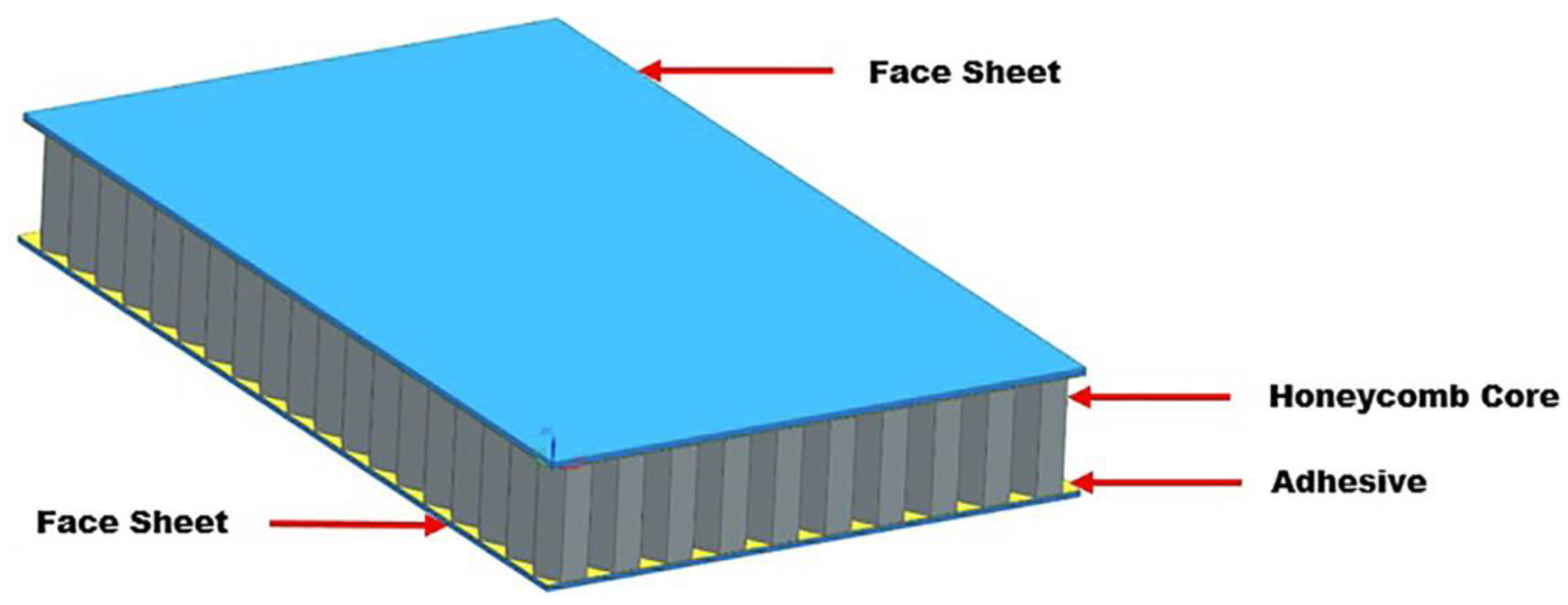
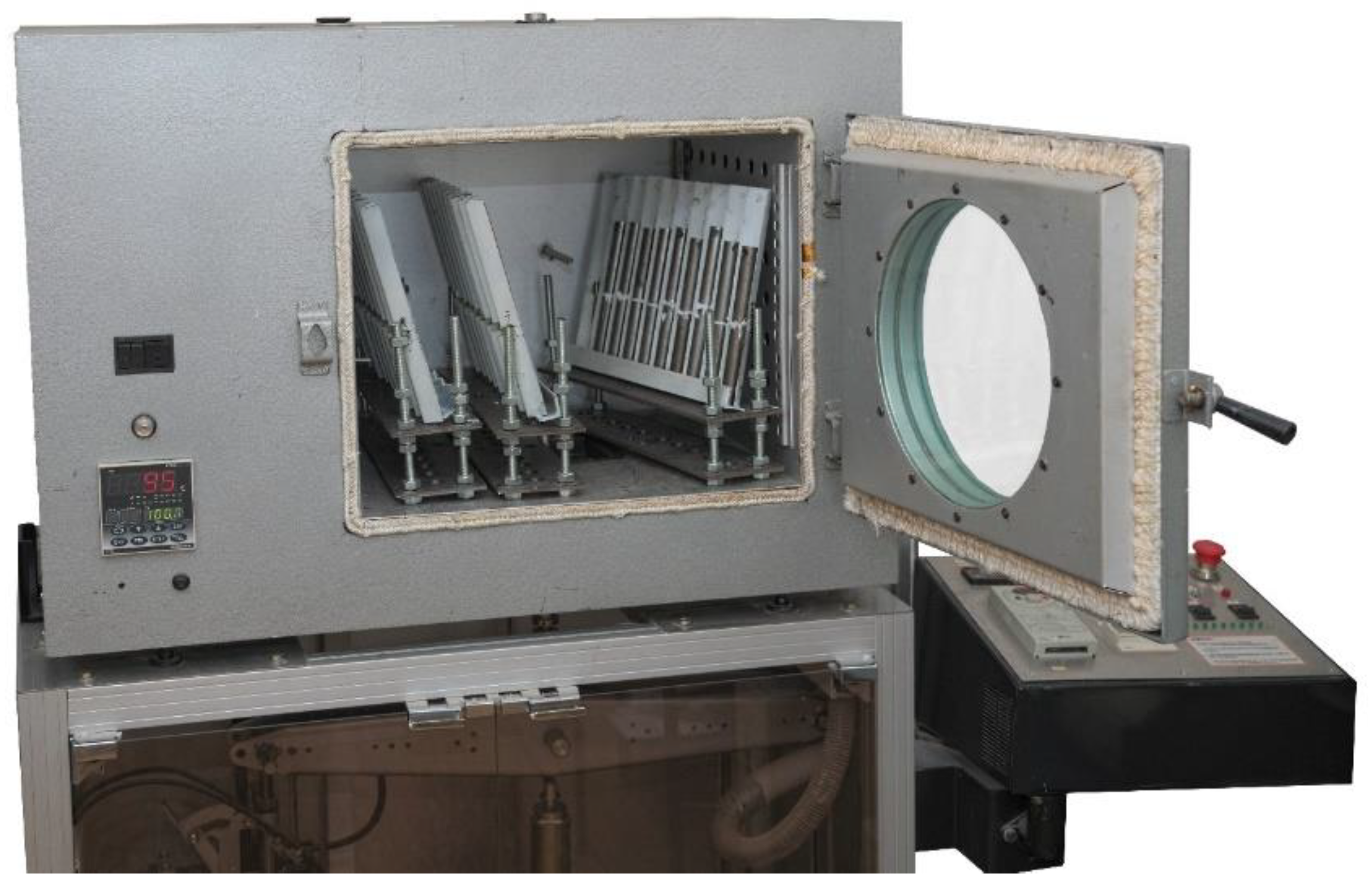
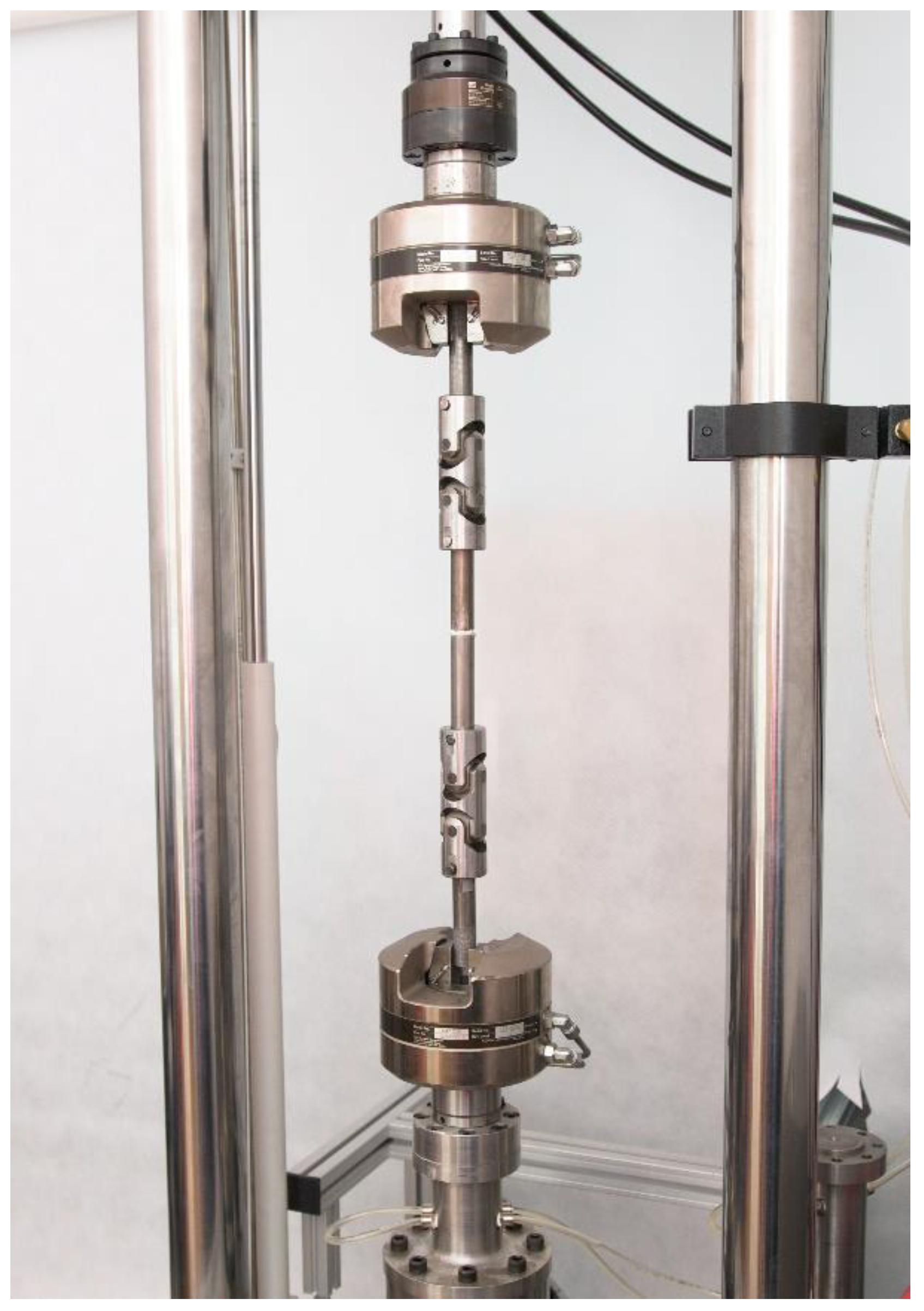
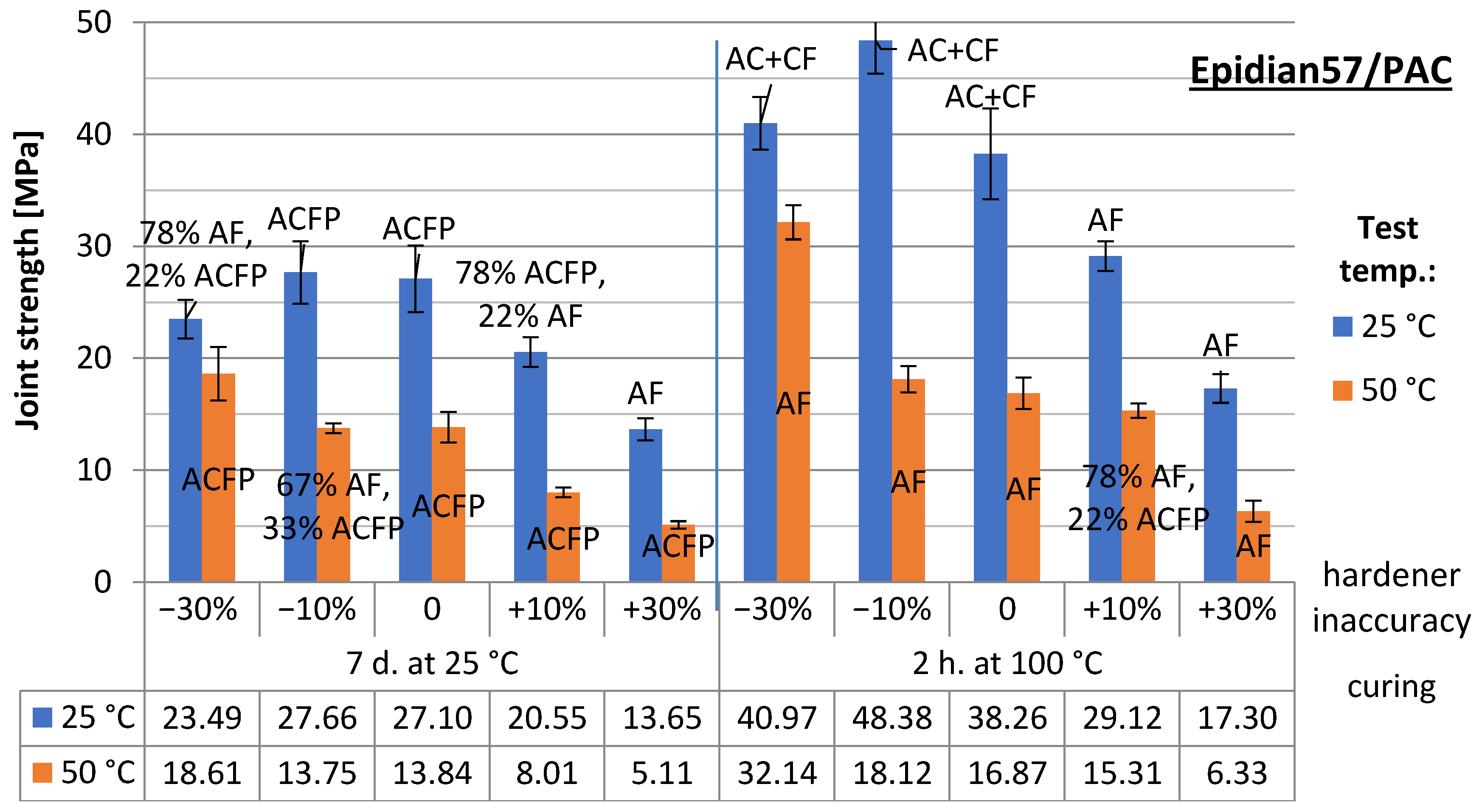

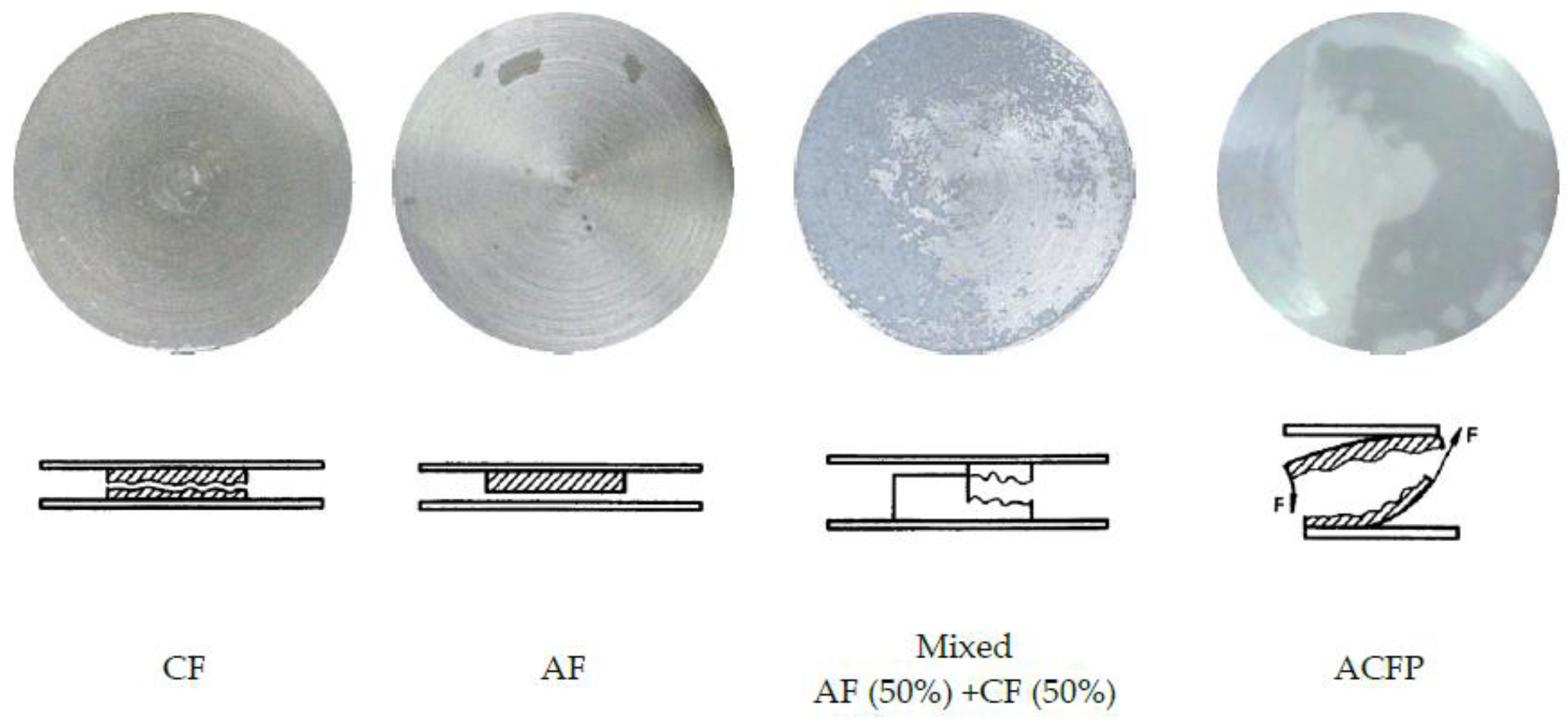
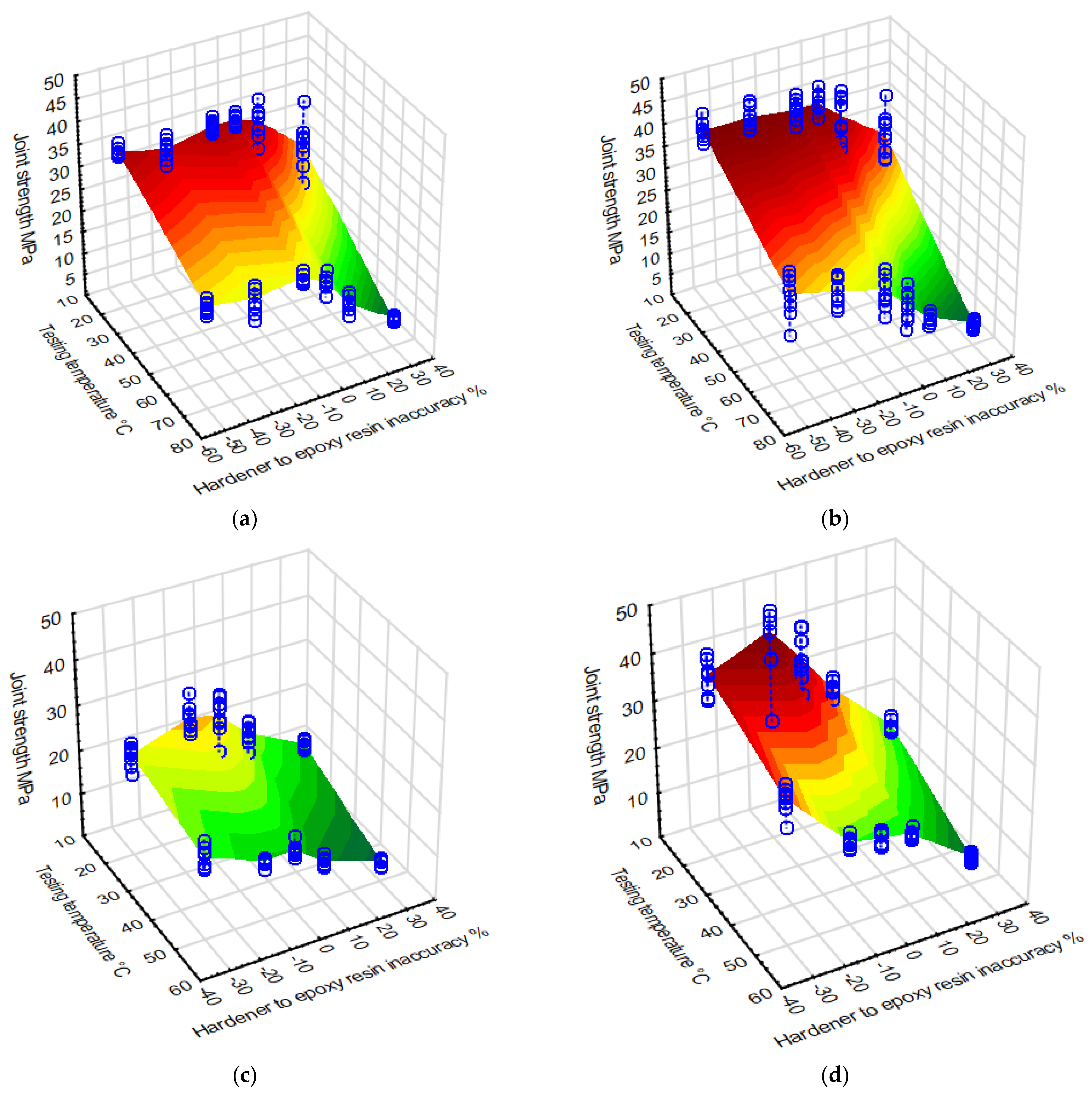
| Curing Conditions | 3 Days in 20 °C | 1 h in 100 °C | |||||
|---|---|---|---|---|---|---|---|
| Hardener Inaccuracy | Mean Strength (MPa) at 20 °C | 1 | 2 | Mean Strength (MPa) at 20 °C | 1 | 2 | 3 |
| −50% | 35.81 | X | 41.06 | X | |||
| −30% | 33.46 | X | 41.12 | X | |||
| −10% | 35.68 | X | 39.89 | X | X | ||
| 0% | 35.51 | X | 39.90 | X | X | ||
| 10% | 33.82 | X | 35.71 | X | |||
| 30% | 25.44 | X | 28.50 | X | |||
| Curing Conditions | 3 Days in 20 °C | 1 h in 100 °C | |||||||||
|---|---|---|---|---|---|---|---|---|---|---|---|
| Hardener Inaccuracy | Mean Strength (MPa) at 70 °C | 1 | 2 | 3 | 4 | Mean Strength (MPa) at 70 °C | 1 | 2 | 3 | 4 | 5 |
| −50% | 23.18 | X | 25.67 | X | |||||||
| −30% | 21.60 | X | X | 23.09 | X | X | |||||
| −10% | 22.67 | X | X | 19.93 | X | ||||||
| 0% | 20.12 | X | 14.77 | X | |||||||
| 10% | 13.49 | X | 10.10 | X | |||||||
| 30% | 6.64 | X | 5.25 | X | |||||||
| Curing Conditions | 7 Days in 20 °C | 2 h in 100 °C | ||||||||
|---|---|---|---|---|---|---|---|---|---|---|
| Hardener Inaccuracy | Mean Strength (MPa) at 20 °C | 1 | 2 | 3 | 4 | Mean Strength (MPa) at 20 °C | 1 | 2 | 3 | 4 |
| −30% | 22.88 | X | X | 39.50 | X | |||||
| −10% | 27.39 | X | 47.21 | X | ||||||
| 0% | 25.95 | X | X | 37.29 | X | |||||
| 10% | 19.97 | X | 29.12 | X | ||||||
| 30% | 13.65 | X | 17.30 | X | ||||||
| Curing Conditions | 7 Days in 20 °C | 2 h in 100 °C | ||||||||
|---|---|---|---|---|---|---|---|---|---|---|
| Hardener Inaccuracy | Mean Strength (MPa) at 50 °C | 1 | 2 | 3 | 4 | Mean Strength (MPa) at 50 °C | 1 | 2 | 3 | 4 |
| −30% | 18.10 | X | 31.41 | X | ||||||
| −10% | 13.71 | X | 18.13 | X | ||||||
| 0% | 13.84 | X | 16.87 | X | X | |||||
| 10% | 9.09 | X | 15.55 | X | ||||||
| 30% | 4.79 | X | 6.39 | X | ||||||
| Adhesive | Test Temperature | Curing Conditions | a | b | R2 |
|---|---|---|---|---|---|
| H9492 | 20 °C | 1 h at 100 °C | 36.43 | −14.50 | 0.473 |
| H9492 | 20 °C | 3 d at 20 °C | 32.53 | −9.28 | 0.291 |
| H9492 | 70 °C | 1 h at 100 °C | 14.22 | −26.73 | 0.804 |
| H9492 | 70 °C | 3 d at 20 °C | 16.36 | −19.28 | 0.673 |
| E57 + PAC | 20 °C | 2 h at 100 °C | 33.61 | −41.16 | 0.611 |
| E57 + PAC | 20 °C | 7 d at 20 °C | 22.13 | −17.17 | 0.380 |
| E57 + PAC | 50 °C | 2 h at 100 °C | 17.67 | −38.82 | 0.909 |
| E57 + PAC | 50 °C | 7 d at 20 °C | 11.97 | −23.03 | 0.888 |
| Adhesive | Test Temperature | Curing Conditions | a | b | c | R2 |
|---|---|---|---|---|---|---|
| H9492 | 20 °C | 1 h at 100 °C | 38.48 | −21.99 | −35.16 | 0.651 |
| H9492 | 20 °C | 3 d at 20 °C | 34.34 | 16.44 | −31.94 | 0.514 |
| H9492 | 70 °C | 1 h at 100 °C | 15.28 | −30.71 | −18.37 | 0.822 |
| H9492 | 70 °C | 3 d at 20 °C | 18.69 | −28.51 | −41.56 | 0.874 |
| E57 + PAC | 20 °C | 2 h at 100 °C | 37.76 | −41.16 | −103.68 | 0.774 |
| E57 + PAC | 20 °C | 7 d at 20 °C | 24.94 | −17.96 | −75.51 | 0.697 |
| E57 + PAC | 50 °C | 2 h at 100 °C | 16.70 | −38.82 | 24.35 | 0.924 |
| E57 + PAC | 50 °C | 7 d at 20 °C | 12.29 | −22.98 | −7.74 | 0.892 |
Publisher’s Note: MDPI stays neutral with regard to jurisdictional claims in published maps and institutional affiliations. |
© 2022 by the authors. Licensee MDPI, Basel, Switzerland. This article is an open access article distributed under the terms and conditions of the Creative Commons Attribution (CC BY) license (https://creativecommons.org/licenses/by/4.0/).
Share and Cite
Szabelski, J.; Karpiński, R.; Jonak, J.; Frigione, M. Adhesive Joint Degradation Due to Hardener-to-Epoxy Ratio Inaccuracy under Varying Curing and Thermal Operating Conditions. Materials 2022, 15, 7765. https://doi.org/10.3390/ma15217765
Szabelski J, Karpiński R, Jonak J, Frigione M. Adhesive Joint Degradation Due to Hardener-to-Epoxy Ratio Inaccuracy under Varying Curing and Thermal Operating Conditions. Materials. 2022; 15(21):7765. https://doi.org/10.3390/ma15217765
Chicago/Turabian StyleSzabelski, Jakub, Robert Karpiński, Józef Jonak, and Mariaenrica Frigione. 2022. "Adhesive Joint Degradation Due to Hardener-to-Epoxy Ratio Inaccuracy under Varying Curing and Thermal Operating Conditions" Materials 15, no. 21: 7765. https://doi.org/10.3390/ma15217765







